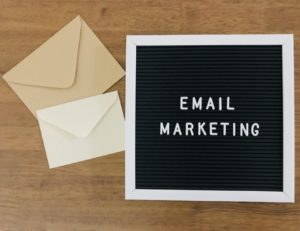We aren’t specialists in email marketing, however, after years of working in marketing, we’ve picked up a few great tips.
Email marketing is an essential part of customer management for ecommerce. When a customer subscribes to your email list, they enter into a relationship with your brand. This customer-brand relationship is like a lifecycle, so it’s often referred to as lifecycle marketing. “Lifecycle marketing happens when retailers send customers emails that are relevant to what stage they are at in the customer lifecycle (source).” The four main stages of the lifecycle include: acquiring, onboarding, targeting, and retention. In this blog, we’ll share some tips to help you along each stage of the lifecycle.
Before you begin, consider your personas and your clients. If you haven’t already established a target audience, now is the time to do it. Know exactly who you’re planning to reach and spend some time thinking about their buying habits. How will you reach them? What should your brand be trying to convey? If you need some extra help with this, here’s a great guide from Quick Sprout.
 Acquiring
Acquiring
Once you’ve carved out your target audience, now you can establish your acquiring goals. Start hammering out where customers are going to sign up for your email list, whether it be on your blog, through a pop up on the home page, or a form on the footer, etc. Next, think about unknown visitors and how you can convert them from prospects to customers. Finally, implement your acquiring strategy using best practices for getting new email subscribers: via a pop-up and on social media. You should have a pop-up on your website that grabs the attention of visitors and prompts them to enter their email. On social, any time you run ads to launch a campaign, email signup should be a condition of entry — and incentives (like free downloadable content) are great ways to entice new subscribers.
Onboarding
Consider where they came from to place them in the best list (which will help on the next step of targeting). Are they signing up on your blog page? Then they may want blog updates. Are they signing up on checkout? What kinds of emails are they looking for there? Or are they signing up for a promo code? They’ll probably want that promo code now and other promo codes and sales in the future.
Consider if you want to send an email for a double opt-in, confirming their subscription. This will help protect you from the spam bucket and make sure that they actually meant to be subscribed to your email list. Introduce yourself to them, explain who you are, and tell them what they can gain from your emails.
If they signed up on a promo code page, you don’t need a double opt-in, but make sure you have an onboarding email thanking them for signing up for the promo code, sending the promo code, and then possibly an introduction about the company with a few products or service highlights.
Targeting
Enjoy this part! Treat is all as experimentation as ways to improve your relationships with customers and content offerings. Who are you sending your emails to? What are their personas? What do they want in their inbox from you? These are all questions you need to ask yourself while discovering the best way to target your clients. A few ways to get started:
o Run some A/B tests
o Send sales at a set frequency (monthly, weekly) and send abandoned cart emails
o Introduce a new product to them through email or send a specialized product highlight email
o Determine which clients go to which emails; create different emails for them based on where they were acquired from and what their interests are
o Run A/B tests again!
Retention
Test out strategies and possibly remove people from the list when you aren’t seeing great interaction rates. This helps you avoid being unsubscribed from which can get you pushed into “spam”.
When removing people, you can tell them you aren’t going to send them emails anymore – let them opt in again, separate email list, a new campaign.
Action Items:
- Go on your website and sign up for your own email list. What welcome emails do you get, and what do they say? Revise if they don’t have an introduction and explanation of who you are, as well as a value-added incentive to stay subscribed.
- Analyze the personas more, you aren’t Amazon 😉